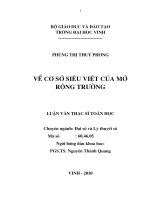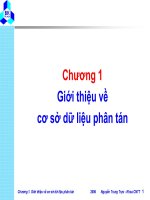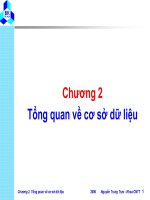VẼ CƠ KHÍ Chapter 8 chain transmission
Bạn đang xem bản rút gọn của tài liệu. Xem và tải ngay bản đầy đủ của tài liệu tại đây (682.75 KB, 19 trang )
CHAIN
JACK CHAIN
DIMEMSION OF ROLLER CHAIN DISK
HOW TO DRAW A ROLLER CHAIN DISK
SPROCKET WHEEL AND
CHAIN—
Pitch radius is at the centre
of the rivets, with a slight
clearance for easy running.
LINK BELT AND PULLEY
—
A variety of hook link forms
are in use for link belt trans
mission
CHINESE WINDLASS—
The sheave and hook rises
equal to one-half the
difference in the
circumference of the barrels
for each turn of the crank.
See No. 27 for the power.
CHINESE SHAFT
DERRICK—
The sheaves suspended
from the upper part of the
derrick legs allows the
bucket to be raised above
the mouth of the shaft or pit
by the differential windlass.
ROPE TRANSMISSION
from vertical to horizontal shaft, with
tension slide and weight.
ROPE TRANSMISSION
to a movable shaft at right angles from the
driving-shaft, with tension slide and weight.
TOOTHED LINK CHAIN
AND PULLEY
, alternating double and
single links.
STEP GEAR—
A spur gear in which the
face is divided into two or
more sections, with the
teeth of each section set
forward a half or third of the
pitch, according to the
number of sections.
A ROLLER CHAIN
JENSEN FF MK1 4WD TRAIN UNIT REMOVAL
It is necessary to remove the gearbox/torque converter and chain unit as an assembly
to gain access to the inside of the chain drive./The transmission is straightforward to
remove but is very heavy. Mechanical aids are required to deal with supporting the
Weight, particularly during reassembly.
Remove the rear prop shaft by splitting the universal joint at the axle and pulling the
shaft out of the transmission. Disconnect the front drive shaft at the flange plate
Couplings each end and remove the support bearing bracket and starter motor.
Access to the shaft and
it's removal is much easier if the cross member running under the rear of the engine
sump is removed. Replace the crossmember after removing the shaft and use it to
support the weight of the back of the engine using a block of wood as a spacer and
load spreader under the sump.Release the gearshift and downshift cable linkages
and Maxaret cables, then unbolt the bell housing from the engine and remove the
rear crossmember/gearbox mounting. The transmission assembly will move
backwards and down clear of the car. Ensure that the torque converter remains fully
located in the bell housing during removal.If working in a pit and not using jacks, it
will take four strong pairs of hands to handle the weight.Removing the chain unit
from the differential and gearbox is covered in the works manual.
(Martin Robey can supply a good quality copy of the original works manual.)
DISMANTLING.
Dismantling the chain unit is straightforward. Some of the bolts holding the
case together and the Maxaret bolts can only be turned with an open
ended spanner as the heads are too close to the case to allow the use of a
ring or socket spanner. Before splitting the case, remove the bearing cap at
the rear of the front wheel drive shaft preserving the shims under the cap.
The screws are secured with Loctite and are very difficult to release. (Try
an impact wrench) Under the cap is an outside circlip which retains the
front drive shaft. Remove the clip and drive the shaft forwards to remove it.
The shaft must be deflected away from the casing as it moves forward to
allow it to pass projections on the case. If the two halves of the case are
difficult to separate, assemble two diagonally opposite bolts back into the
case leaving them about 3/8" proud. Then tap the heads gently with a
hammer and the case will part..
The driven chain sprockets will be loose in the case with the front drive
shaft removed. This allows the sprockets to be lifted out and the three
chains removed. There is a spacer between each sprocket. Note also that
the rear bearing for the front drive shaft is fitted with a flanged reducing
bush in the centre. If the bearing is to be replaced, press the bush out
before discarding the old bearing.
.
If it is intended to replace the large bearings on the driving sprocket shaft,
then the driving sprocket gear cluster will need to be removed from the
rear casing. This requires a special tool to release the locking ring which
has four notches cut into the outside diameter. There is a lock tab washer
under the ring which is deformed into two of the notches. Punch the locks
flat first and then release the ring. Again, the ring is secured with Loctite
and is very difficult to release even with a tool.
If replacing bearings, the outer shells of the taper roller bearings are a
tight fit in the casing. If the shells get a bit damaged removing them it does
not matter but to preserve the new ones in good condition try putting the
shells in the deep freeze while the case goes in the fan oven at 100
degrees C for 10 minutes. The shrinkage of the bearing shell and the
expansion of the casing are such that, using gloves, the new shells
literally drop in place and tighten as the temperatures equalise. The
reverse works well for fitting bearings to shafts. i.e. bearings in oven, shaft
in freezer. Don't be tempted to use a blow lamp to heat bearings and
particularly casings. The heat can be uneven and crack cases or destroy
temper of bearings
REASSEMBLY
Reassembly is self evident and the reverse of the dismantling sequence. I could not
locate any gaskets for the casing so I made my own from 15 thou paper gasket sheet.
The seals and bearings are all available from bearing suppliers using the numbers in the
list. Note that taper roller bearings require two numbers, one inner and one outer, as the
makers mix and match inners and outers.
I failed to locate a source of Morse chains so reused the original ones despite them
being slightly stretched. The Maxaret unit has a special thick cork gasket which I
obtained from Cropredy Bridge Garage. When refitting the torque converter to the
gearbox check that the converter is fully home into the pump drive. It can give the
appearance of being in place but is in fact too far out on the shaft making it impossible
to assemble to the engine. To check, measure the distance between the front face of the
bell casing and the top face of the bolt holes that secure the converter to the engine
crank. This must be at least 1/2".
The LinearChain is able to move loads
horizontally and vertically.
The LinearChain is made of specially
formed links, whose geometry prevents the
chain from buckling under load. This allows
the LinearChain to work like a conventional
linear actuator.
Benefits at a glance:
Ideal for realizing long strokes, especially
for applications where space is limited
Compact storage, also in multi-axis
applications
Constant, shock-free motion
Synchronous operation for horizontal or
vertical motion









